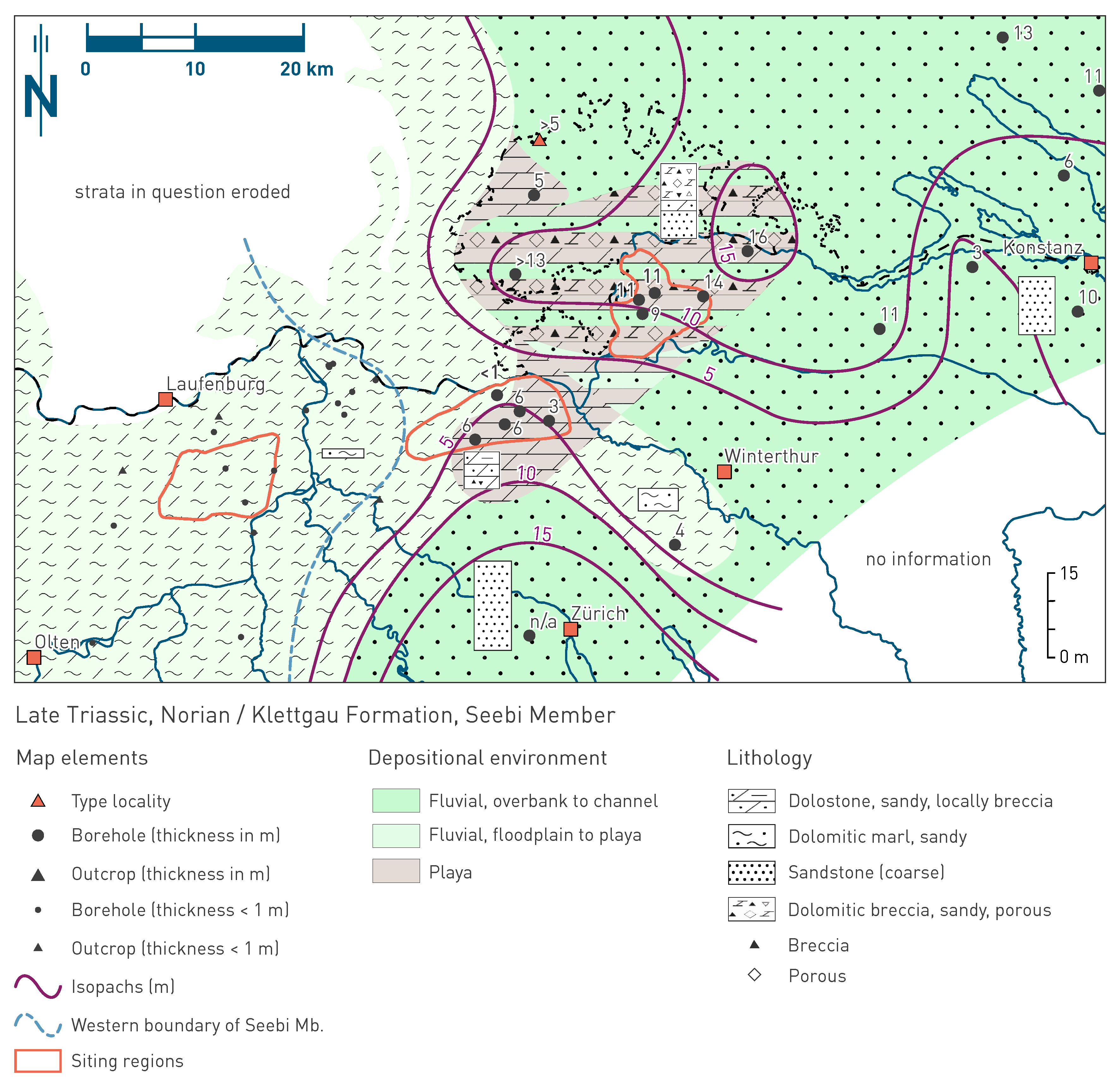The Klettgau Formation was deposited in the southern part of the Central European Basin. During the long time span (some 30 Myr) from Middle Carnian to end Rhaetian, this basin underwent a very complex evolution resulting in a variety of different facies realms (Fig. 4‑13). They include terrestrial fluvial and playa environments as well as short marine ingressions. Sedimentary provenance also varies throughout the depositional evolution of the formation. At the beginning it was mostly the southern Norwegian Caledonides (Paul et al. 2008), later the Vindelician – Bohemian Massif (Wurster 1968). During the fluvial periods, channel fill sediments as well as overbank and evaporite sediments have been deposited in a vast continental playa under (semi)arid conditions (Fig. 3‑7). The marine ingressions are characterised by up to several metre-scale, partly stromatolitic carbonate layers, anhydrite sabkha sediments and estuarine sandstone. Despite the long period of deposition, the preserved succession is thin. As the deposits are not condensed, it can be assumed that most of the time is represented by gaps in sedimentation. Several erosive phases during deposition can be distinguished that partly resulted in deep incisions into the underlying strata. Even though channel-fill intervals of the Klettgau Formation were associated with very high sedimentation rates, the unit, including the erosive gaps, is characterised by low to very low sedimentation rates (Fig. 4‑4, Fig. 4‑5, Fig. 4‑6). The depositional evolution of the Klettgau Formation is subdivided here into five time intervals:
The first time interval (227_Car_300 to 227_Car_200, Middle Carnian) corresponds approximately to the deposition of dolomitic marls of the Ergolz Member (Fig. 4‑15). These dolomitic marls originated in vast floodplains of a playa system («floodplain facies»), which were intersected by fluvial channels («channel facies»; Fig. 4‑17). The channels reach depths of at least 7 m (STA2). Between these two facies associations, in a channel-proximal position and in overspills sand and silt layers are interbedded with dolomitic marls («overbank facies»). Dolomitic nodules, desiccation cracks, bioturbation and plant root tubes demonstrate relatively stable phases of soil formation and the development of vegetation covers in the floodplain.
The second time interval (227_Car_200 to 227_Car_100, Late Carnian) primarily corresponds to the Gansingen Member and reflects deposition during a transgression from the southwest, from the Burgundy Gate (Jordan et al. 2016b). From west to east, a shallow marine to lagoonal depositional environment existed (mostly carbonate deposition) that transitioned into a sabkha environment (mostly sulphate deposition), which is bordered by a terrestrial proximal fluvial fan (sandstone deposition, Berlingen Member; Fig. 4‑20). This suggests clastic input from the Vindelician – Bohemian Massif. The marine character of the Gansingen Member is also evidenced by the fossil record (Wildi 1976). Locally, the thickness of the Gansingen Member is significantly reduced, and its top is erosive (Jordan et al. 2016a).
The third time interval (227_Car_100 to 208.5_Nor_200, Late Carnian to Norian) corresponds approximately to the deposition of the strata in the lower part of the Gruhalde Member. The prevailing dolomitic marls document a return of a fluvial depositional environment similar to the Ergolz Member. However, at this time the «floodplain facies» were mostly deposited.
The fourth time interval (208.5_Nor_200 to 208.5_Nor_100, Norian) approximately corresponds to the Seebi Member. Proximal fluvial fans reached Northern Switzerland from the northeast and probably from the south (Fig. 3‑7, Fig. 4‑21). The source was the Vindelician – Bohemian Massif in the northeast and probably its promontory, the Alemannic Land, in the south. The influence of these fans is most evident in the lower part of the Seebi Member in ZNO and decreases towards the west; in JO the Seebi Member is < 1 m thick. In the ZNO siting region the sandy facies was superseded by a more dolomitic facies with brecciated dolocretes with vugs representing a playa environment. In NL the Seebi Member is also dominated by a dolomitic facies but without vugs. In the light of this, it is postulated that particularly the eastern sector of ZNO was dominated by
a playa depositional environment in which evaporitic minerals were formed that were subsequently dissolved leading to the formation of vugs. Towards the west less evaporites were formed, which resulted in reduced macroporosity.
The fifth time interval (208.5_Nor_100 to 201.4_Rha_100, Norian up to Rhaetian) approximately corresponds to the deposition of the strata in the upper part of the Gruhalde Member and the thin Belchen Member, where it survived later erosion. During this time period, mostly dolomitic and argillaceous marls were deposited in floodplains («floodplain facies»), which formed the habitat for plateosaurs (Hofmann & Sander 2014). This terrestrial depositional environment was terminated by a transgression during the Rhaetian (e.g. Schneebeli-Hermann et al. 2018). The sedimentary rocks of the Belchen Member were deposited in an estuarine to shallow marine depositional environment (Looser et al. 2018). Finally, the top of the Klettgau Formation constitutes a major erosive unconformity.

Fig. 4‑21:Map of depositional environments during the Late Triassic (Norian) preserved in the Seebi Member of the Klettgau Formation and its western equivalent (part of the Gruhalde Member of the Klettgau Formation)
Refer to Fig. 4‑3 for a schematic representation of depositional environments. The north arrow refers to present-day geographic north.

